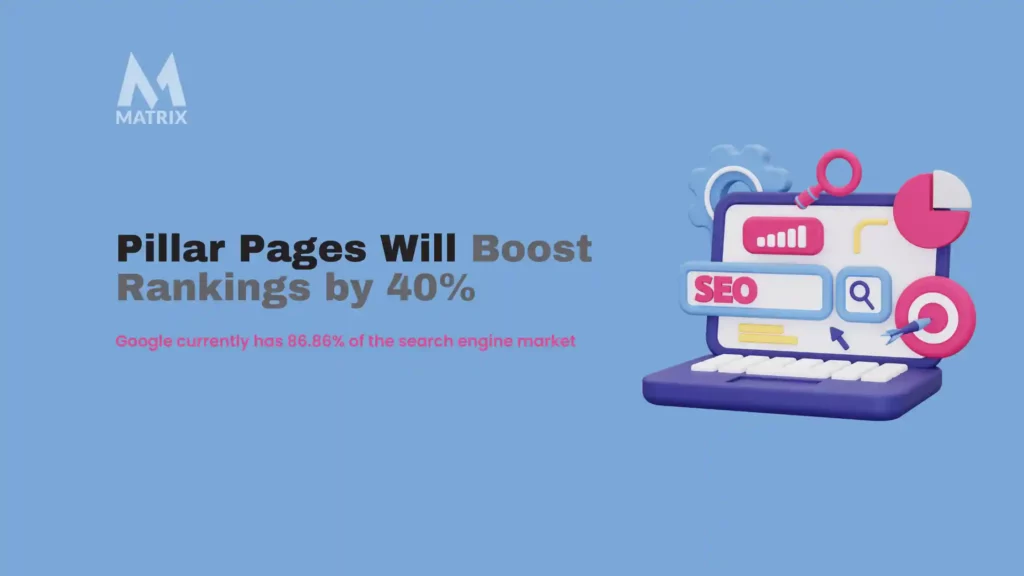Learn how to use pillar pages to boost your search rankings by 40%
Pillar pages and topic clusters are not often discussed in content creation and management, but when used correctly, they could become an excellent asset for search ranking boosts.
After all, in any discussion about marketing online, content remains one of the primary factors driving traffic to a website.
The article about topic clusters and pillar pages will cover the following:
- pillar pages examples
- types of cornerstone pages
- how to create pillar pages
- pillar page best practices
- 10x content cornerstone page
- pillar content strategy
A company could employ numerous techniques to improve website traffic, but visitors won’t stay for long without the right content and content marketing.
SEO tuning is also important in mobile-optimized websites, as many people who browse through their phones are often in transit and looking for something interesting to read to pass the time.
And if they are caught in a topic cluster they like on your website, they will stick around.
When it comes to good content, there are many techniques to try. Some tell a story for a brand even when they don’t appear to do so implicitly.
But one of the underutilized but effective tactics to draw in traffic and boost search rankings with content marketing is using topic clusters on cornerstone pages.

The Pillars of Content Marketing Success
The term “pillar page” may not be as familiar to some people online, but content marketers may have heard of it before in the race to keep up with the changes Google implements on its search engine.
As the company dictates how SEO works through algorithm tweaks, SEO marketers must adapt.
There’s always a constant need to adjust to the changing algorithm, and updates to any company’s content strategy come with those changes.
And one of the more recent updates suggests that topic clusters may be the way to go.
One of the more significant changes that Google has put out onto its algorithm is that it takes a site’s “authority” as part of the qualification of whether or not a website or web page will rank high on search results for specific keywords.
This means that content specialists have to create excellent content with the right keywords and structure the content on the site so that it demonstrates their authority on a particular subject.
Because of this significant change, it becomes evident that companies need to use a cornerstone page and topic clusters to establish their site as the kind of authority that Google’s algorithm will place high up on the search results.
A pillar page is a page that can give the reader a comprehensive overview of a topic. It works in conjunction with the topic clusters. Imagine the cornerstone page as the trunk of a tree.
The topic clusters are this tree’s larger support branches, spreading into smaller branches or subtopics. The topic clusters are interlinked articles and web pages discussing a specific topic or revolving around a particular keyword.
The cornerstone page connects and holds them together, giving the website structure and helping Google understand the site better.
Power of the Topic Cluster: Why Use It or Pillar Pages?

Consider this: When did you last take a “wiki walk”? This is an instance where, while reading an article, you click an interesting link within it, linking to another page within the same site that discusses a different aspect of the same or similar topic.
Soon, you traverse multiple pages, reading your way around the site. This is what topic clusters are noted for; they can give customers interconnected sources of information that will keep them on the site and engaged.
This web of connected content experiences is of incredible value to any website and the reader seeking vital information. Furthermore, it establishes the site to Google as an authority.
Choosing a topic over keywords might be a little strange, but Google’s changes to the algorithm don’t only rank pages now with considerations for authority. It also better understands semantic keywords, conversational language, and other colloquialisms.
As a result, it can better understand what the user is searching for and what specific topic cluster they want.
Keywords alone can’t define the complexities of the human language used to search for something they are looking for, and they can’t always determine the searcher’s intent.
Take, for example, someone searching for a movie or TV show. They only vaguely remember a scene and a location, not the name.
If the algorithm relied on keywords, the results wouldn’t send back what they were looking for since the keyword to the movie or the show would be its name.
But with the new algorithm change, the topic cluster or pillar pages is picked up. Words about the movie or the TV show are considered, and the title is returned as a search result.
The topic clusters will work the same for company websites as customers search for something related and end up at the site’s cornerstone page that holds it all together.
Suppose a potential site visitor is browsing for travel through Europe, and a site’s cornerstone page has several good sightseeing destinations for different European countries. In that case, it could rank high on the new algorithm.
Quality vs. Quantity: Why Choose? Get Both.

People are on the internet because it’s humankind’s most incredible information tool.
People go to search engines and browse websites to learn something and for entertainment. And if the website provides high-quality content in large quantities, users will return.
However, such information is a haphazard mishmash of various topics for many websites. It can be cumbersome.
After all, one of the cardinal rules of creating content for websites is to be as concise as possible; having too much content on a website could make it difficult for search engines to crawl them.
The individual pages would also compete with each other on the rankings.
But a website carefully structured to use the topic cluster or cornerstone page strategy will have a large quantity of useful content that has already been carefully sorted and classified, making it easier for users to navigate. It improves the overall user experience and keeps users returning to it.
It further boosts the site’s presence as an authority on the subject when it’s easily navigable, understandable, and informative.
And most of all, it will ensure that search engines can still crawl them quickly and efficiently, leading to better rankings.
Activate Your Brand For More Sales Today!
Clusters and the Real Impact on SERPs
Cambria Davies and Hubspot looked more deeply into whether topic clusters impact website presence in search engine results in webpages (SERPs).
The study, which was extensive in its findings, underscored that more interlinking occurred with this content strategy. And the website did far better in SERPs with more interlinking.
The more tightly woven the content, the more internal links the strategy produces, and the higher the SERP placement. There were also more views and impressions from users.
The same also applied when they increased outbound external links. After creating a new topic cluster, they created outbound external links in the subpages toward other pages with relevant content.
This method shows Google that the topic cluster created is a one-stop-shop for a great deal of information on the subject, making Google rank it higher in the SERPs.
These strategies showed clear indicators of growth. This was compounded by updating existing site content to reflect more current information and adjusting it to the new content strategy, which led to a definite boost in organic traffic growth.
Posts with updated content, optimized links, and added page relevancy increased weekly search traffic growth. Maximum growth was also achieved when the site doubled on a single primary topic across all its content.
Utilizing topic clusters for your website makes it more engaging and valuable to readers.
Meanwhile, having a pillar page to organize the clusters makes it easier for Google to learn your site and build it up as a trustworthy authority in specific keywords and topics.
Bump and Boost: Tips to Boost Rankings Through Clusters and Pillars

Using clusters and cornerstones makes it far easier to climb up the ranks of Google’s search results, especially after the significant changes to the algorithm.
It’s time that site owners take the opportunity to restructure their site and its content and start generating pages containing related content.
To get started on developing topic clusters for a website to give it that much-needed ranking boost, you could try the following tips:
Create a cornerstone page or article.
Returning to the tree analogy, a robust foundational branch must be established. Start with content or a page on the site that discusses the main topic. From this page, the topic cluster can begin by linking the article to other pages within the site, all falling under the pillar’s primary subject.
These could be articles that elaborated on specific points in the main article or other aspects that haven’t been discussed. This is also an excellent tactic for targeting keywords with a high search volume and plenty of competition and difficulty. Start with a short-tail keyword for the cornerstone and then long-tail keywords for the subsequent articles linked to it in the topic cluster.
Do a comprehensive audit of the current content.
Using a pillar page and clusters strategy will require an overhaul of how content is distributed from the website.
It’s hard to reorganize when you don’t know what you have. One crucial thing that site owners shouldn’t overlook is auditing the existing content.
Categorize them into their topics and determine where bridges or clusters can be built among them. The topics can be pretty broad, and you might be surprised at how much existing content can be changed, expanded, or even turned into a pillar with supplementary articles.

Better Search Ranking
Better Search Ranking in 90 days
SEO is extremely important for companies to rank well in search engines because it is the primary way that people find information online.
Dive deep into the pillar pages.
The topic selected for a cornerstone could be pretty broad. If you start with something like “IT security,” it could expand into any number of topic subpages, with some of the subjects becoming their pillars.
At this point, don’t be afraid to dive deep when building the cornerstone page itself. It could go all the way up to 3,000 words or more. Organize it by cutting it down to subheadings and subcategories in digestible chunks, similar to what happens on a Wikipedia page.
Remember, this page aims to branch out to as much of the cluster as possible. It becomes central to the rest of the cluster as a hub for all the other pages users will click from.
Strategize the subtopics.
The problem with choosing a broad main topic is what to write about it next. There are just so many potential options and new topics that could branch out from it. They might even end up being topic clusters of their own.
Instead of going through each possible connection, strategize the subtopics or articles coming after the pillar.
One great way to do this is by connecting with the customer service or social media team. Ask them the most common questions, what is often asked by the current customers, and what potential customers typically look for. From there, you can start planning subtopics to link to the central pillar that answers customers’ questions.
Check for gaps and dead zones.
Once you’ve done a complete audit of the existing content, identify what connects to a pillar, what can be expanded, and other present issues, and figure out what isn’t there.
Gaps in the content, issues, or topics that haven’t been addressed can be identified by doing these.
From here, these topics could be added to the content strategy. The new subtopics and subpages can be carefully constructed according to the new layout and fit better among the new clusters.
They can also address new ideas and concepts the company may want to introduce to answer the queries or a business’s natural expansion.
Try to use LSI keywords.
When creating your pillar page or designing your topic clusters, Latent Semantic Indexing keywords are another tool you can utilize for better search engine placement.
These are connected to the main keywords found on the pillar page.
With the LSI keywords, Google can improve the search experience for users to determine the search’s intent.
Sprinkle in these keywords through the content, creating more context to the post instead of just using the same keywords repeatedly.
Guest post articles are your friends.
The other advantage of topic clusters is that they can significantly aid an existing backlinking campaign.
Backlinking and similar strategies work well in conjunction with this structure, but it can improve further by creating a guest-posting strategy.
This allows you to publish posts by way of high-quality publications. At the same time, you can link back to your pillar pages on the topic.
This will significantly boost the search ranking and establish the site as a considerable authority. The topic clusters don’t have to be on your site they could be on other authoritative websites.
Add a “relevant content” section after the blog posts.
You might have noticed that each post is followed by a content section at the bottom on many authoritative sites (news sites, popular blogs, and more). This relevant content section contains “further reading” for your site visitors.
If they haven’t clicked through the links in the article’s body, they’ll find more informative pages and articles about the topic they just read about elsewhere on the site.
This relevant content doesn’t have to be restricted to links to more articles either; it could lead to reviews, comparative notes, infographics, or other content they might want to read about.
Pillar page examples
Also known as a content pillar, topic cluster, or power page, a pillar page or pillar post is a web page that covers the overall topic in-depth and links to the clusters of related content. Three commonly used pillar page types are:
- 10x content pillar page
- Resource pillar page
- Product or service pillar page
10X content pillar page
A 10x pillar page generally contains your owned media, “ the content you own and control. The format is similar to an ungated e-book or a guide.
Resource pillar page
The resource pillar page is a bookmarkable reference page of valuable like-themed links. When creating pages like this, your linking strategy is essential to consider. Let’s review three ways to create it.
Service pillar page
If your business offers various products and services, you might benefit from a pillar page focused on a product or service. A good example is the Matrix Marketing Group’s service pillar page on its marketing manufacturing services.
Final words on Pillar Pages
Overall, the topic cluster strategy and pillar pages call for an overhaul of the website. It’s a transformation specifically designed to adhere to the new algorithm, as defined by Google.
It will take a significant amount of work, content shifting, and all original content that must be created. But once all is said and done, it can give the website a surprising boost in Google search result rankings.
Beyond that, it could establish the website as an authority, not just to Google but also to readers, driving them to reference the site repeatedly. All it takes is to grow the site like a tree with strong foundations and branches and continually let it grow.
Have you experienced challenges in dealing with Google’s algorithm changes? Would topic clusters be something that could work for your website? Why or why not? Let us know in the comments below.
We’re listening.
Do you have something to say about your thoughts on pillar pages or topic clusters?
UPDATED 2023
Share it with us on Facebook, Twitter, or LinkedIn.
General FAQs
What is a pillar page?

Also known as a content pillar or power page, a pillar page is a web page that covers the overall topic in-depth and links to the clusters of related content. Three commonly used pillar page types are 10x content pillar pages.
How many pillar pages should you have?

There are no explicit guidelines for how long your pillar page should be, but if you‘re going to be comprehensive, you should probably aim for at least 2,500 words and try to stay under 6,000 (remember, you‘ll go more in-depth on subtopics in other posts).
What is the topic cluster?
What Are Topic Clusters? A topic cluster is a group of interlinked web pages. They’re built around one pillar content targeting a broad topic linked to several related but more narrowly focused pages.
Why are topic clusters important?
A topic cluster is multiple pieces of content grouped by a shared topic and related subtopics. As a whole, these pages offer comprehensive coverage of a specific subject. That enables visitors to satisfy their search queries while visiting your site.

